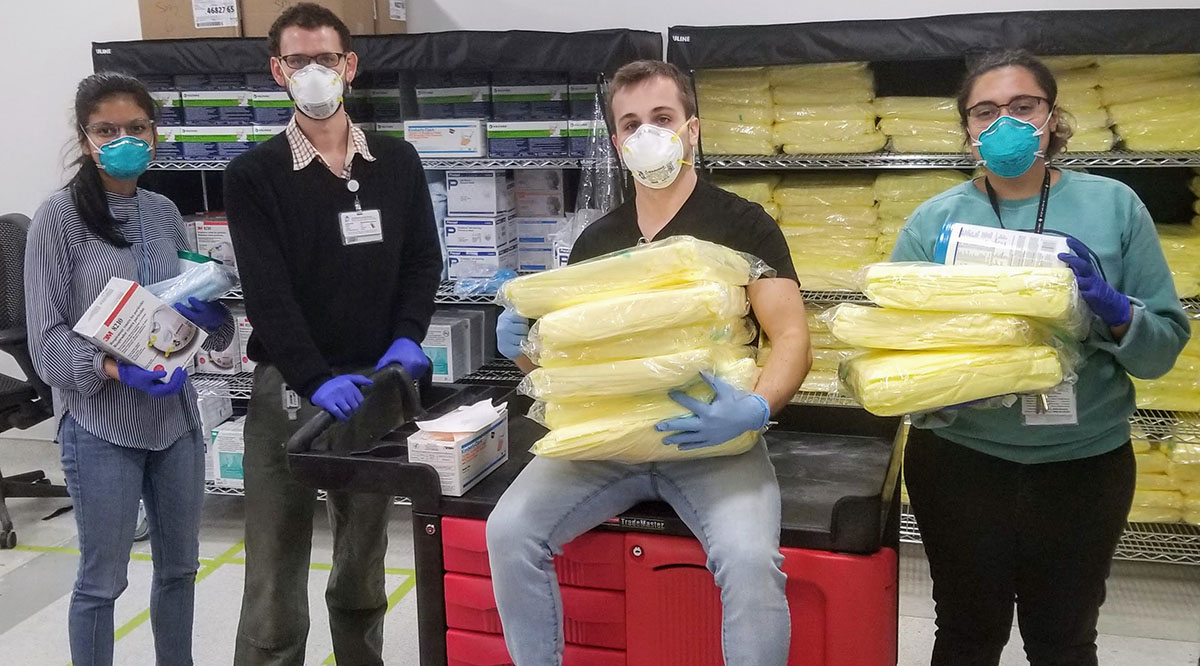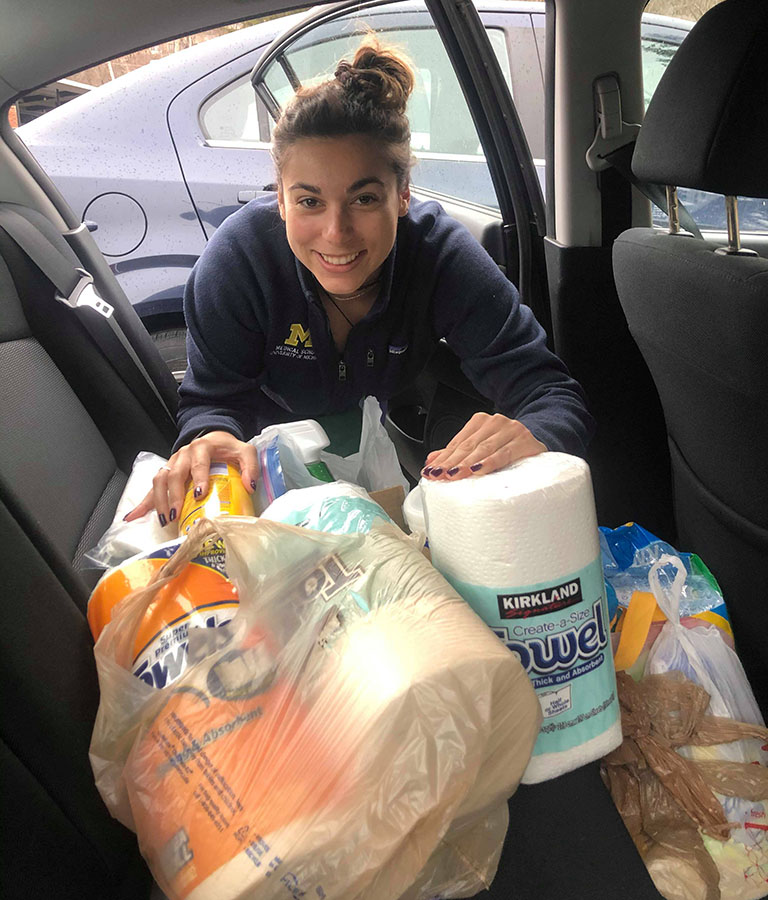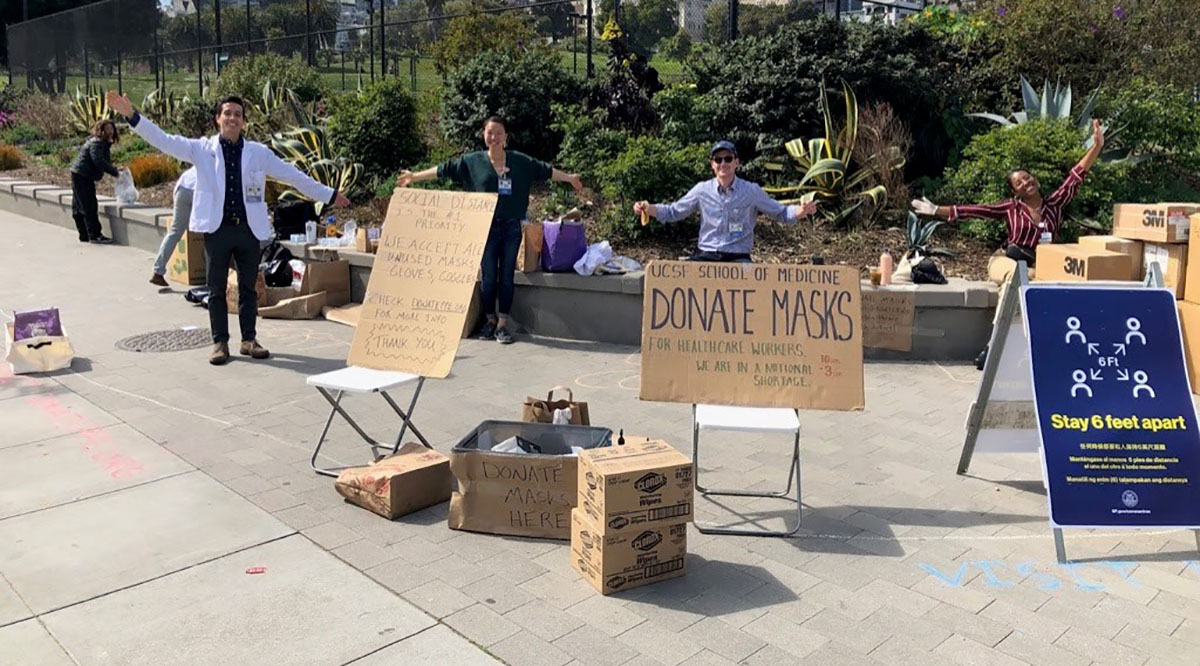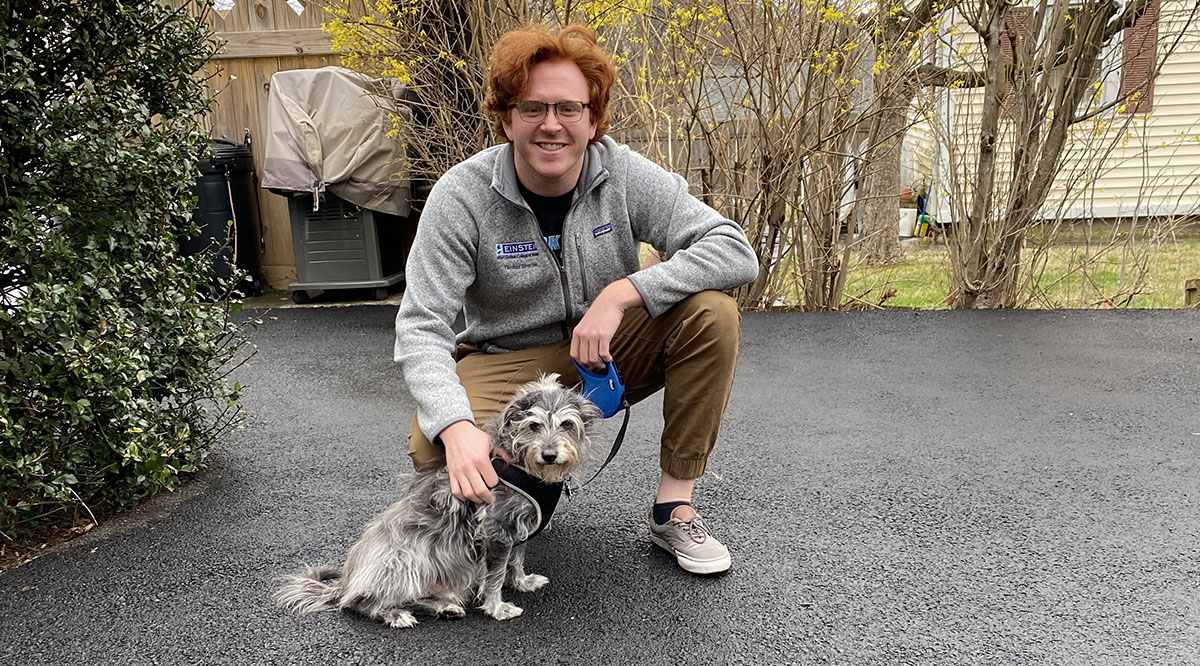
After the University of Michigan Medical School announced it was moving all classes online three weeks ago, first-year student Kenzie Corbin was having trouble sleeping.
She wasn’t worried about her coursework or her career. She was concerned about the COVID-19 pandemic possibly devastating the people experiencing homelessness whom she serves through Wolverine Street Medicine, a corps of medical students that works on the streets and in clinics. Corbin realized she could help by providing hand sanitizer, but it was tough to get. Determined, she pulled together a recipe — isopropyl alcohol, aloe vera gel, and essential oil — based on Centers for Disease Control and Prevention (CDC) guidance, and started whipping up her own batches. And when those ingredients began running out, she asked fellow students to donate them. In just a few days, she and her classmates managed to distribute more than 100 bottles of their homemade sanitizer to shelters in Detroit and Ann Arbor.
Meanwhile, other students at her school had sprung into action with their own COVID-19-related projects, from walking providers’ dogs to shopping for elderly neighbors, ultimately coming together as a robust volunteer network called M Response Corps.
At the same time, similar efforts were unfolding at dozens of other U.S. schools as medical students sent home from classrooms and clinics sought ways to contribute in the face of an unprecedented health crisis.
“My current priority is how I can act immediately to help save lives,” says Corbin. “I couldn't just sit here and not help.”
Thousands of others feel the same way, with some putting in 40-plus hours a week and launching volunteer projects almost overnight. They are gathering protective equipment, organizing blood drives, staffing phone lines, and stepping up in myriad other ways that are making the faculty members who support them — and themselves — proud.

“When you get on a Zoom meeting and there are something like 100 students offering ideas and willing to jump in however they can, it’s inspiring,” says Tony Asher, a third-year student and volunteer leader at the University of North Carolina (UNC) at Chapel Hill School of Medicine. “It makes you realize that people really went into medicine for the right reasons.”
Through all they’re doing, future physicians are learning essential lessons and developing talents that might have otherwise remained untapped.
“I think about the highly stressed workforce students will be entering soon and I see how the skills and attitudes they’re building as volunteers are essential,” says Lyuba Konopasek, MD, senior associate dean of education at the Frank H. Netter MD School of Medicine at Quinnipiac University in North Haven, Connecticut.
Konopasek shares another point that many students make as well: “It’s also absolutely critical for their emotional well-being that they are given the chance to contribute at this challenging time.”
From the loading dock to the lab
Although the AAMC strongly suggests that medical students not be involved in any direct patient care unless there is a critical workforce need locally, there are still many ways students are able to step up in health care settings.
Last week, Jordan Hughes and some of his University of Texas (UT) Southwestern Medical School peers spent the day loading oxygen masks, catheters, and other essential supplies onto carts and then delivering them to storage rooms throughout the hospital.
“I don’t think any of us came to medical school to work in the warehouse,” says Hughes. “But at the moment, working in the warehouse and taking patients’ food orders are some of the best ways we can help patients. We are freeing up staff to do other work, and we are allowing staff who may have been exposed to stay at home.”
“It’s also absolutely critical for their emotional well-being that they are given the chance to contribute at this challenging time.”
Lyuba Konopasek, MD
Frank H. Netter MD School of Medicine at Quinnipiac University
Some of Hughes’ fellow UT volunteers — in just one week, more than 200 contributed 1,383 hours — have been able to work in a more clinical setting. Fourth-year students, for example, have been answering phone queries to lighten the load of emergency department staff flooded with calls.
At the Icahn School of Medicine at Mount Sinai, students are answering questions via telehealth technology using decision trees and prepared scripts. The 500-member group also tackles various other volunteer jobs that span six categories, including research, where a key focus is possible COVID-19 treatments.
“Mount Sinai is ramping up efforts to use antibodies from recovered patients,” explains one leader, Rohini Bahethi, a third-year student. “Our students are going through hundreds of emails from patients who want to donate plasma, trying to help figure out who should be enrolled in trials and talking to potential candidates about their eligibility.”
Other Icahn volunteers have been trained to act as temporary pharmacy technicians, sorting prescriptions and delivering medications — and recently came up with a creative way to contribute.
“They devised a new system to track COVID-19 medication usage rates,” explains Bahethi. “The hope is that the information will be useful given that COVID patients and other patients may all need similar medications.”
While many students work to prop up research and patient care, others are trying to staunch the spread of the novel coronavirus. At UNC, for example, some students are helping teach staff how to don and doff personal protective equipment correctly. Others are screening people outside the hospital’s clinic, taking temperatures and asking anyone who registers above 100.4 to call for further guidance.
“The students have been at the doors from 7 a.m. to 7 p.m., Monday through Friday, and people really appreciate it,” explains third-year student Phil Barker. “Sometimes, it feels like what you’re doing is kind of routine, but really for each person that you’re checking and helping others keep safe, it does make a big difference.”
Collecting essentials
In San Francisco, one community crisis helped address another: In the wake of wildfires last year, many people had purchased face masks they no longer needed and were willing to donate to hospital workers who desperately need them now.
Over the course of a week, University of California, San Francisco (UCSF), School of Medicine students collected 23,000 masks at outdoor drives, says second-year student Hunter Jackson, who is helping run several community efforts in the Bay Area.
“On the first day, we dropped off masks at one hospital and doctors met us at the door,” says Jackson. “That afternoon they had temporarily run out of masks, so our donation was a direct buttress for them. That was scary to see, but we were glad to be able to help.”
Across the country, scores of other medical students are doing similar work, in part through such groups as the med student-created Medical Supply Drive Coalition. The coalition now counts nearly 400 volunteers in 37 states, and the numbers of volunteers are likely to grow as the American Hospital Association launches its ambitious #100millionmasks drive.
UCSF students also identified another major community need: blood donations. “Students have been partnering with local blood banks and the university,” explains Jackson. “They are working on a lot of logistics, including finding spaces, coordinating volunteers, and making sure that the drive is done safely. And dozens of students are donating blood,” he adds. “The sign-up sheet was filled almost immediately after we put it up.”
"Even as we are doing nitty-gritty tasks like moving boxes, we have a sense that we’re contributing to something much bigger.”
Rohini Bahethi
Icahn School of Medicine at Mount Sinai
Meanwhile, student volunteers across the country are working to address the basic needs of those battered by the outbreak. At UNC, for example, students have been dropping off cleaning supplies, food, and medications to quarantined families.
“It can be tough for people who don’t have anyone to help and who can’t afford services like Amazon," says Barker. “The help has been a big relief to a lot of patients and also to social workers who’ve been stressed trying to figure out how to get these items to people.”

UNC students are also helping in the community in another, more novel way. They are accompanying paramedics on visits to patients too sick to go out but too well to need hospitalization.
“Students wear masks and don’t actually go inside the residence,” explains Barker. “If the paramedic needs anything — something back in the car, for example — they call out to the student so the paramedic doesn’t have to take off all their PPE.”
“They can be the hands of the paramedic,” Barker adds. “The paramedics really appreciate it. As you can imagine, they’ve been stretched pretty thin lately.”
Tele-volunteering, 3D printing, and more
“I want to make clear that not all students are able to volunteer in the trenches," notes Konopasek. “Some of them have their own medical issues or live with people who are at risk. … If [those people] are at home making masks, that’s incredible.”
In fact, one day after Konopasek’s team asked for mask-sewing volunteers, 17 students had already stepped up. They’ll be working with several hospitals, each of which have different specifications for homemade masks but all of which follow CDC guidance that cloth masks are appropriate when all other options have been exhausted.
Volunteers elsewhere are hoping to produce face masks with a more high-tech tool: 3D printers. Corbin’s fellow student Michelle Benedict is spearheading that effort, working with Michigan Medicine to follow their specifications. As a former project manager in Silicon Valley, she’s aiming to pump out hundreds of masks with the help of her onetime high-tech colleagues.

And there are scores of other ways to help from home. Medical students at Harvard Medical School, for example, have been making infographics designed to educate the public, which they share via Instagram.
Icahn fourth-year student Ben Asriel is sheltering in place with his in-laws in Florida but is working hard to organize students to make crucial phone calls for NYC Health + Hospitals. The public hospital agency — which is weighed down by a huge backlog of COVID-19 test results — asked for 200 student volunteers to call patients with results, he explains.
“We are setting up a system where negative results will be assigned to nonclinical students. Positive results will go to clinical students who will use a decision tree to guide conversations with patients,” Asriel says.
Asriel sees his contribution as not only letting people know whether they are well but also bolstering faith in the medical system. He notes that friends were told they’d have test results in two days but later learned it would take 10. “They didn’t feel very well taken care of,” he says. “The delivery of results affects how people view the health care system. And right now we really need people to trust what they’re hearing from the system.”
The evolution of a movement
At first, UNC students hoping to help simply started looking for opportunities on their own. Soon, though, they connected with school leaders, and in short order they were in touch with faculty every day.
Elsewhere, projects often took a similar tack as students and schools collaborated to ensure the greatest volunteer output with the least possible risk. “We’ve connected students with hospital leaders to make sure the most urgent needs are addressed and to provide immediate feedback,” says UT Southwestern dean Angela Mihalic, MD.
At Netter, volunteers created a sophisticated tiered system, with students contributing more directly over time as the pandemic progresses and local needs increase. Some of that strategy grew out of Konopasek’s earlier experience as a dean in New York City on 9/11. “I watched students literally run towards the Twin Towers,” she said. “That’s who they are. Currently, we need to help our students make wise choices about how to help.”
Meanwhile, students say they are learning profound lessons from their volunteer efforts.
For one, they appreciate the interprofessional opportunities they’ve been afforded. “It was really incredible to see how the warehouse works," says Hughes. “As a physician, you’re taking care of patients, but you don’t think about how many people have to work together for you to effectively do your job. I was in awe.”
Bahethi articulates another major benefit. “We realize that we have a voice,” she says. “Maybe we are even laying the groundwork for how the student workforce can contribute in the future. Even as we are doing nitty-gritty tasks like moving boxes, we have a sense that we’re contributing to something much bigger.”
UT Southwestern dean Mihalic agrees that today’s students are tomorrow’s hope. “This has been a really stressful time,” she says. “It’s a time of tremendous concerns and disappointments. And through it all the students have remained a shining light.”
